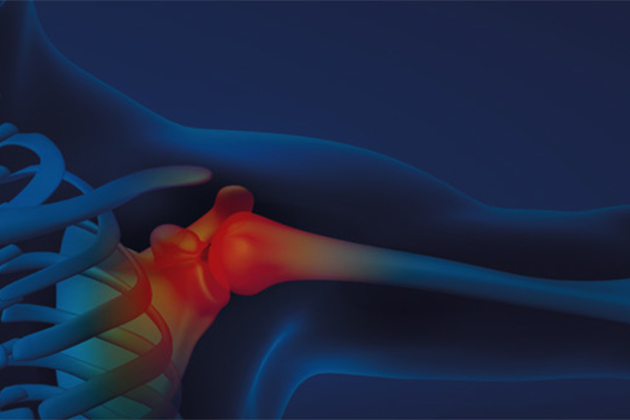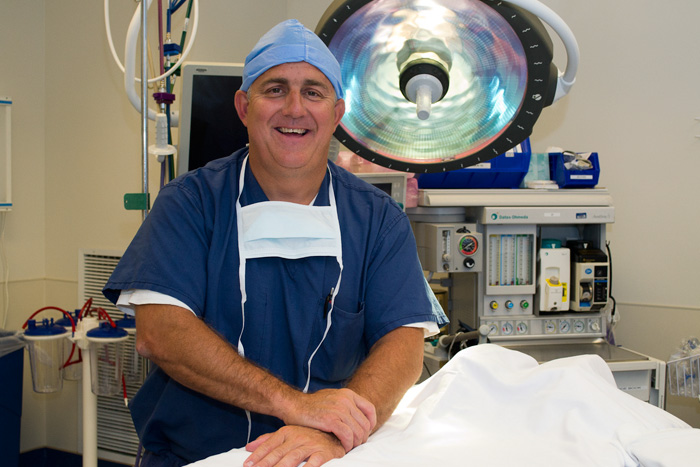He’s shirtless when he steps into the camera frame, late 30s, brown hair with a mustache. He swings his arms out to the side and back down, then straight up and down.
“That guy’s amazing. He was hit by a train,” says Augustus D. Mazzocca, chairman of UConn’s department of orthopedic surgery and director of the Musculoskeletal Institute at UConn Health. As if he heard Mazzocca’s words, the man in the video drops, wraps his hand behind his back, and does a one-armed pushup.
After the train accident, Mazzocca’s team repaired the group of muscles and tendons, known as the rotator cuff, that kept the man’s arm firmly in his shoulder socket. The video was taken half a year after that surgery. It’s impressive. Watching the guy, you’d never know he’d had a traumatic injury.

He’s one of the lucky ones. Rotator cuffs injuries are very common, due to overuse, sports injuries, and other, unknown reasons. They don’t always heal, leaving patients unable to lift or move their arms, and doctors don’t always know why. Sometimes muscles degrade faster than they regenerate. Sometimes tendons don’t reattach to the bone, or mysteriously atrophy until they’re too short to do anything. Sometimes a patient has a lot of pain and limited movement for no obvious reason.
“The patient with a bad outcome is the patient that drives us,” Mazzocca says. He leads a team of researchers searching for better ways to heal stubborn rotator cuff injuries. They’re testing the physical limits of surgical repair, comparing physical therapy techniques to find the fastest, most effective regimens, and cultivating the body’s ability to heal itself with its own adult stem cells.
Mechanical repairs
In a lab down the hall from Mazzocca, research engineer Elifho Obopilwe is sitting next to a workbench. There’s a clamp mounted to it, with a Dremel tool laying nearby. The lab feels very much like a high-end auto body shop, except for the human shoulder bone mounted to what looks like the business end of a giant nutcracker. “That’s a glenosphere,” Obopilwe says.

A ball-shaped implant that sits in the shoulder socket and fits into a cup at the end of the arm bone, a glenosphere is used in reverse total shoulder arthroplasty – called ‘reverse’ because in normal human anatomy, the ball-shaped top of the arm bone fits into the cup of the shoulder socket. But some older patients’ rotator cuffs are so far gone, the surgeon has to substitute the deltoid muscles of the upper back instead. To have the arm move normally using the deltoid muscles, the usual ball-and-socket structure has to be reversed.
Obopilwe is testing how much strain a newly-repaired reverse total shoulder arthroplasty can take. The giant nutcracker is a really a Material Testing System (MTS) machine. The MTS presses down or pulls up with a certain force, over and over and over again. Sensors attached to the bone and tendon can report exactly how much strain the shoulder feels. And if the repair fails – if a tendon tears or a bone breaks – the sensor record will tell exactly how much force was too much. Right now Obopilwe has it set to 100 newtons of force, or about how much you would feel if you extended your arm straight out and lifted it to parallel with your shoulder.

Since testing repairs until failure would not be ethical to carry out on living people, Obopilwe uses pieces of cadavers. Cadavers don’t heal or change. When the surgeon tries out a new repair on a cadaver, that repair has the strength and resilience that it would on a live person the moment they come out of surgery, before they start to heal. The physical tests Obopilwe conducts on these cadaver repairs are like a snapshot picture of what a person can do in that moment after surgery. Of course patients don’t move their arms immediately after surgery, but the cadaver tests give an idea of the minimum strength a patient will have.
“That will give the surgeon the confidence to tell the patient, ‘Start moving’,” Obopilwe says.
Getting patients moving and using their arm safely and comfortably is the goal. Part of Mazzocca’s team focuses on the results, tracking the clinical outcomes of the surgeries as carefully as they test the mechanical repairs. They test different physical therapy regimens to see which ones help patients recover fastest and most completely. True success is determined by what the patient can do, and how good they feel. A successful surgery not only repairs torn tissue and gets the patient moving her arm again, it improves her quality of life. You want her to not just be able to move her arm again – you want her to do it without pain, to be able to sleep on it, stretch it, hold a partner and dance.
Healing at the cellular level
But some patients, about 15 percent, just don’t heal. The tendon doesn’t regrow or reattach to the bone. The UConn team suspects the reason could be biological, a failure of the body to communicate at the cellular level.
To jumpstart the body’s healing process, they do something very unusual. They harvest the patient’s own stem cells during the surgery, concentrate them, and then deliver them into the repair. These adult stem cells, harvested from bone marrow within the patient’s humeral bone, have the potential to turn into bone, tendon, or cartilage.
“They’re confused cells,” cells that have not yet differentiated into a specialized cell type, says Mary Beth McCarthy, a research associate working with the adult stem cells. She knows how to nudge them so they reliably turn into a specific tissue type in a petri dish. But FDA regulations classify such modified stem cells as drugs, and there is no clear path to getting such cell/drugs approved for use in humans.
The patient with a bad outcome is the patient that drives us. — Dr. Augustus D. Mazzocca
Instead, McCarthy is working on a scaffold that can be sutured to the footprint on the bone where the tendon should reattach. The scaffold itself is made of the patient’s own blood plasma and adult stem cells. Down the road, McCarthy sees more studies being done on “smart” scaffolds, where one side of the scaffold will be imbued with molecules that signal stem cells to turn into bone, and the other with signals for tendon. The team hopes that the patients’ stem cells will get the message and grow appropriately, so that even stubborn rotator cuff injuries will heal.
Rotator cuff surgery is a big sacrifice, in time and in pain. Mazzocca is the first to admit it. But if someone has trouble moving his arm, if he’s in pain when he moves, eats, and tries to sleep, he’s usually eager to try to fix it. Fixing it, healing those torn tendons and muscles in the rotator cuff, is the team’s ultimate goal, Mazzocca says. “Someone who hasn’t used his or her arm in 10 to 15 years and you’re able to return that function to them – that’s the big thrill.”


